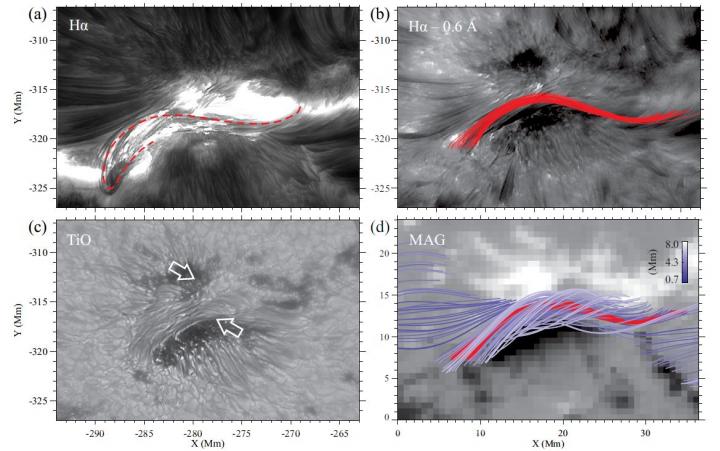NJIT's new solar telescope peers deep into the sun to track the origins of space weather

Fine details of a magnetic flux rope captured by the New Solar Telescope at Big Bear Solar Observatory for Solar Active Region 11817 on 2013 August 11. The structure is further demonstrated by the 3-D magnetic modeling based the observations of Helioseismic and Magnetic Imager on board Solar Dynamic Observatory. Credit: Chang Liu
Scientists at NJIT's Big Bear Solar Observatory (BBSO) have captured the first high-resolution images of the flaring magnetic structures known as solar flux ropes at their point of origin in the Sun's chromosphere. Their research, published today in Nature Communications, provides new insights into the massive eruptions on the Sun's surface responsible for space weather.
Flux ropes are bundles of magnetic fields that together rotate and twist around a common axis, driven by motions in the photosphere, a high-density layer of the Sun's atmosphere below the solar corona and chromosphere. The NJIT images were taken from observations of the newly commissioned 1.6m New Solar Telescope (NST) at BBSO.
“These twisting magnetic loops have been much studied in the Sun's corona, or outer layer, but these are the first high-resolution images of their origination in the chromosphere below it. For the first time, we can see their twisting motion in great detail and watch how it evolves,” said Haimin Wang, distinguished professor of physics at NJIT and the study's lead author.
Wang and his co-authors strung together a series of images which trace the formation of an S-shaped bundle of magnetic fields from which a set of loops peel off and grow upward into a multi-strand flux rope within a few minutes. Two flare ribbons appear at the two sides of the rising flux rope.
“We have been looking for erupting twisted solar flux ropes in the chromosphere, but observations of these eruptions under excellent conditions are very rare,” Wang said, adding that the NST images they captured provide unprecedented detail, as well as powerful new clues about their initiation and their relationship to solar eruptions and coronal mass ejections.
Energy releases in solar flares and associated forms of eruptions occur when magnetic field lines, with their powerful underlying electric currents, are twisted beyond a critical point that can be measured by the number of turns in the twist. The largest of these eruptions cause what is known as space weather – the radiation, energetic particles and magnetic field releases from the Sun powerful enough to cause severe effects in Earth's near environment, such as the disruption of communications, power lines and navigations systems.
“One of the exciting things about these new images is that we can now distinguish between mild twists and those severe enough to cause space weather,” said Wang, who likened the eruptions to earthquakes, which are energy releases following the build-up of tension as tectonic plates rub against each other along fault lines. The team is developing tools to predict space weather from solar observations and modeling.
###
About NJIT
One of the nation's leading public technological universities, New Jersey Institute of Technology (NJIT) is a top-tier research university that prepares students to become leaders in the technology-dependent economy of the 21st century. NJIT's multidisciplinary curriculum and computing-intensive approach to education provide technological proficiency, business acumen and leadership skills. With an enrollment of more than 10,000 graduate and undergraduate students, NJIT offers small-campus intimacy with the resources of a major public research university. NJIT is a global leader in such fields as solar research, nanotechnology, resilient design, tissue engineering and cyber-security, in addition to others. NJIT ranks fifth among U.S. polytechnic universities in research expenditures, topping $110 million, and is among the top 1 percent of public colleges and universities in return on educational investment, according to Payscale.com.
Media Contact
All latest news from the category: Physics and Astronomy
This area deals with the fundamental laws and building blocks of nature and how they interact, the properties and the behavior of matter, and research into space and time and their structures.
innovations-report provides in-depth reports and articles on subjects such as astrophysics, laser technologies, nuclear, quantum, particle and solid-state physics, nanotechnologies, planetary research and findings (Mars, Venus) and developments related to the Hubble Telescope.
Newest articles

Silicon Carbide Innovation Alliance to drive industrial-scale semiconductor work
Known for its ability to withstand extreme environments and high voltages, silicon carbide (SiC) is a semiconducting material made up of silicon and carbon atoms arranged into crystals that is…

New SPECT/CT technique shows impressive biomarker identification
…offers increased access for prostate cancer patients. A novel SPECT/CT acquisition method can accurately detect radiopharmaceutical biodistribution in a convenient manner for prostate cancer patients, opening the door for more…

How 3D printers can give robots a soft touch
Soft skin coverings and touch sensors have emerged as a promising feature for robots that are both safer and more intuitive for human interaction, but they are expensive and difficult…





















